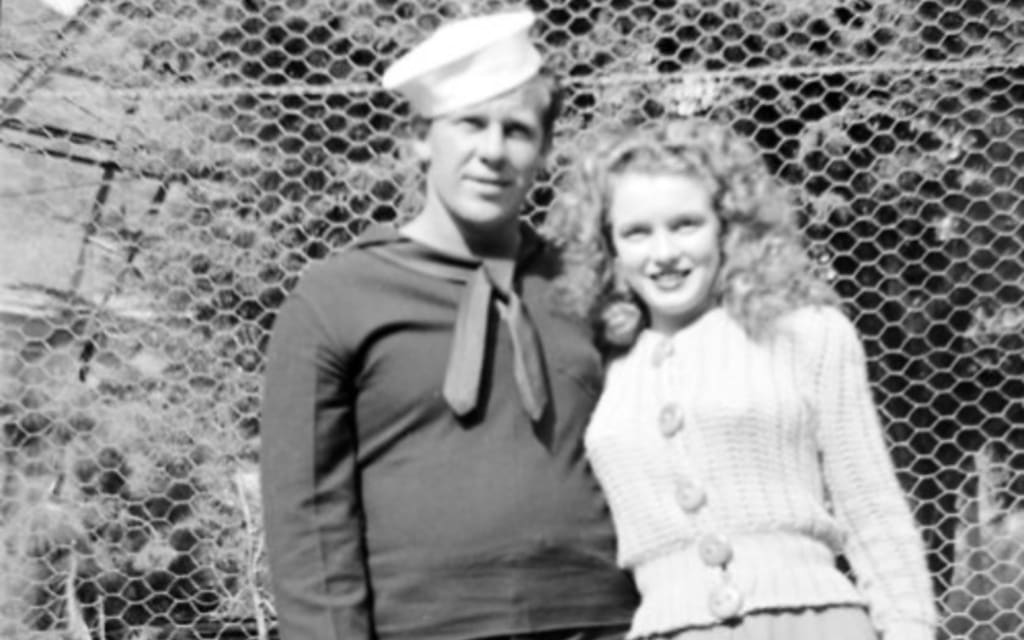Marilyn’s Men: Mrs. Dougherty
Jim Dougherty was one of the few people privileged enough to know Marilyn before she was Marilyn.

Jim Dougherty was one of the few people privileged enough to know Marilyn before she was Marilyn. He had been the next door neighbour of Grace McKee Goddard, long time friend of Marilyn’s mother Gladys and now legal guardian of the 15 year old Norma Jeane, when in 1942 Grace moved out of state due to her husband’s work. Due to state laws, Norma Jeane could not leave the state of California with Grace, and so was facing the daunting possibility of returning to an orphanage. In her turbulent early life, Norma Jeane had been in and out of a multitude of foster homes and orphanages, her mother unable to look after her due to her severe mental health issues, and during this time Norma Jeane had been subjected to physical, mental and sexual abuse by the very people who were supposed to be looking after her. The possibility of returning to this life was frightening to her, but Norma Jeane also expressed fears that she was too young to be a wife. Seemingly caught between a rock and a hard place, Norma Jeane married Jim Dougherty on the 19th of June 1942.
Norma Jeane’s identity as a high school drop out turned child bride is notably just another in a long line of allusions to the original blonde bombshell Jean Harlow. Just like Norma Jeane, Jean married her first husband at 16 and dropped out of high school not long after. Much of Marilyn’s image and ambitions came from her childhood fascination with Jean Harlow, so this parallel between the two proves to be very interesting.
The marriage, however, was not ideal for Norma Jeane nor Jim. Pearl Harbour was still fresh in the nation’s minds, and Jim was eager to join the armed forces as America entered the Second World War. Norma Jeane, however, did not want her husband to be away from her so soon. She was completely dependent on him in their first few months of marriage, dedicating herself to being the perfect housewife and craving his attention and approval entirely.
Jim’s persistent need to ‘do his part’ in the war effort did not relent, and in 1943 he enlisted in the Merchant Marines as a form of compromise – he would be starting his military career but could remain in California, stationed on Catalina Island where his young wife could still live with him on base. Though this compromise worked for a while, Jim longed to be in the action, and in 1944 he shipped out to the Pacific, despite Norma Jeane’s protests.
Once Jim was gone, Norma Jeane was at a loss with what to do with herself. She had spent her life so far either in orphanages, education or as a housewife, and when Jim had left he had taken Norma Jeane’s purpose with him.
In late 1944, Norma Jeane began work at the Radioplane Munitions Factory in Van Nuys as part of her contribution to the war effort. This allowed her the first taste of independence she’d ever experienced – for the first time, she was earning her own income, income she could keep and spend on whatever she liked. This event also marked the turning point that changed Norma Jeane Dougherty into Marilyn Monroe.
As part of the continuous pro-war propaganda, a photographer from Yank Magazine visited the factory at the end of 1944, in order to photograph the female factory workers and promote the Rosie The Riveter image that had become so popular. During this visit, the photographer David Conover found himself entranced by the auburn haired Norma Jeane. Her photographs were not used in the magazine, but Conover’s fascination with the 19 year old grew, and it wasn’t long before he was inundated with requests from his fellow photographers to learn the identity of the factory girl.
The irony of Norma Jeane’s appeal during these early days is that it was so far flung from what she would be known for later on as Marilyn Monroe. When she was signed for the Blue Book Modelling agency in August 1945, her innocence, attainability and girl-next-door vibe was the main source of her allure for the host of photographers who took her picture during this time.
Modelling soon took up so much of her time that Norma Jeane left the factory to work full time posing for men’s magazine and a host of advertisements. By early 1946, her growing ambition and determination had landed her on the cover of 33 magazines, including Peek, Pagaent and Laff.
Early 1946 also marked a key event in the transition from Norma Jeane to Marilyn: Norma Jeane’s naturally curly auburn was straightened and bleached to be the golden blonde that is now synonymous with Marilyn. This was also yet another parallel between Norma Jeane and her idol Jean Harlow, who was the original blonde bombshell of 20th century Hollywood.
Through her connections at the Blue Book Agency, Norma Jeane secured a screen test a time Paramount Pictures in June 1946. Though this was unsuccessful, she was determined to succeed and had a successful screen test with Twentieth Century Fox not long after.
This marks the moment when Norma Jeane officially became Marilyn Monroe. Requiring a stage name for her contract with Fox, she decided to use her mother’s maiden name Monroe. Stuck for a forename, Marilyn was suggested by executive Ben Lyon after Marilyn Miller, a Broadway actress of the early 1900’s who was famed for her ability to play rags-to-riches characters – a likeness to Marilyn’s story that did not go unnoticed by Lyon.
When Jim returned from war in August 1946, he did not recognise his wife. The insecure, dependant young girl he had left behind had been transformed into an independent, ambitious woman who no longer needed her husband’s approval. She had her own dreams and everything needed to achieve them in her own self, no longer needing anyone else.
Jim hated this new lease of life. He wanted a housewife who would think only of him, and who would support him in his ambitions, forgoing her own. The war changed everything. Women had, for the first time, been allowed the independence of earning their own wage and therefore gaining independence that had been otherwise nonexistent before the war. When the war was over, women were expected to return to their pre-war lives as mothers and wives, but it is no surprise that many women struggle with this.
Marilyn was one of these women. During the war, she had proved herself wrong with how well she had coped without Jim. She had been so afraid of being left alone when he was deployed, but without him she didn’t just survive; she thrived. Only a month after Jim’s return, Marilyn filed for divorce. There was a world waiting for her and she refused to be held back by a husband she didn’t even truly love. Norma Jeane was Marilyn now, and Marilyn had big plans.
The first of Marilyn Monroe’s three marriages was the least fulfilling and the only one in which I do not believe there was any love. In Marilyn’s own diaries from the time, she confesses
“My relationship with him was basically insecure from the first night I spent alone with him.”
Though her insecurities would plague her for the rest of her life, Marilyn’s ability to flourish without Jim the mid 40s proved that she was more than the orphaned Norma Jeane, unwanted and ignored. People were paying positive attention to her for the first time in her life; people actually wanted her, and this affirmation was not something she wanted to give up just yet. Marilyn Monroe had a life to live, and that meant that Norma Jeane had to be left behind with Jim Dougherty. He may have known Marilyn before she was Marilyn, but that was not who she truly was – Norma Jeane wasn’t finished becoming what it was she was meant to be yet – that journey would certainly not be easy, but it had to be better than what she had left behind.
About the Creator
Fern Wigfield
I make adventures happen at Merlin Entertainments | A coffee addict who owns too many books | “Without stories, we wouldn't be human beings at all”






Comments
There are no comments for this story
Be the first to respond and start the conversation.